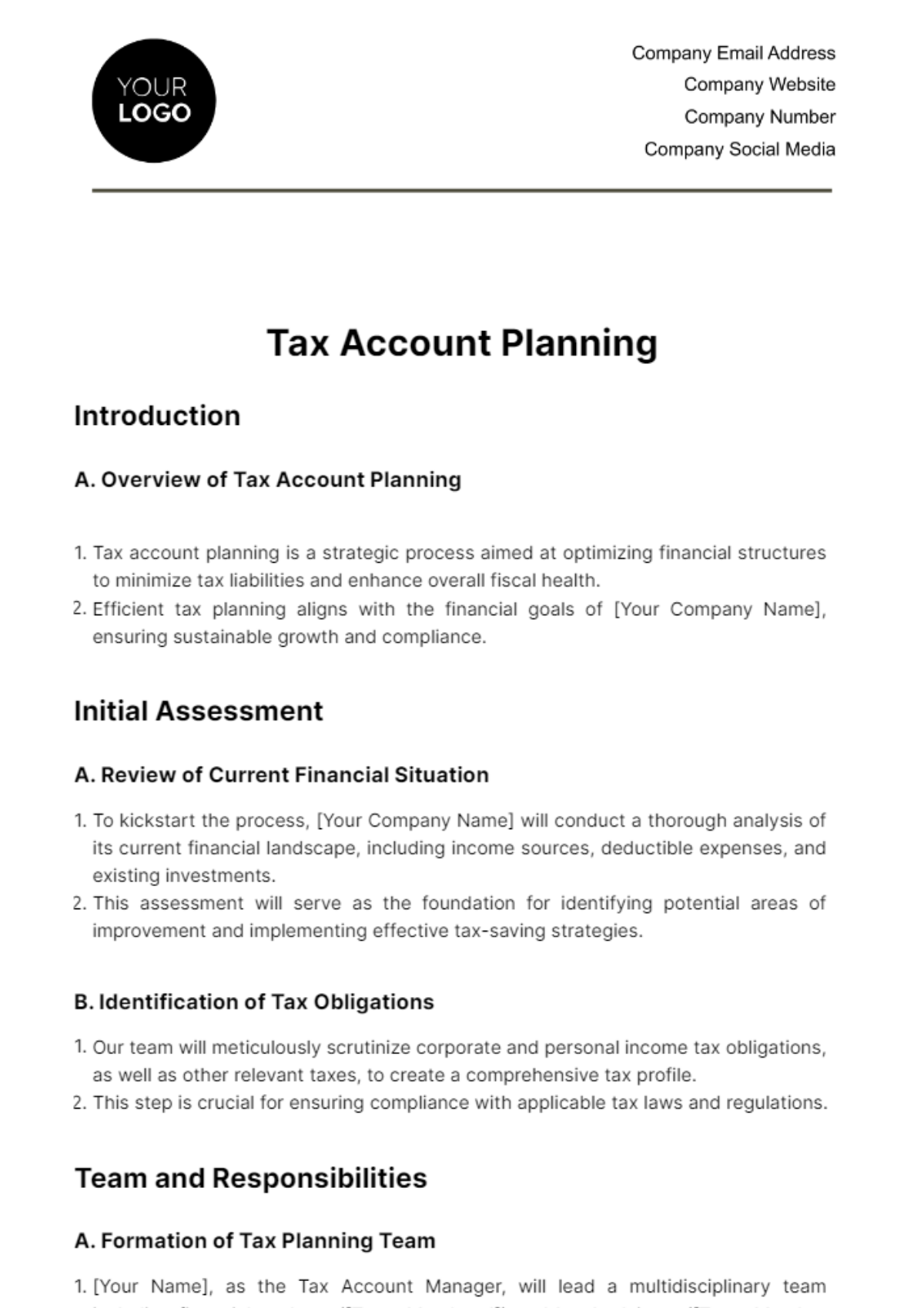Free Tax Account Planning

Introduction
A. Overview of Tax Account Planning
Tax account planning is a strategic process aimed at optimizing financial structures to minimize tax liabilities and enhance overall fiscal health.
Efficient tax planning aligns with the financial goals of [Your Company Name], ensuring sustainable growth and compliance.
Initial Assessment
A. Review of Current Financial Situation
To kickstart the process, [Your Company Name] will conduct a thorough analysis of its current financial landscape, including income sources, deductible expenses, and existing investments.
This assessment will serve as the foundation for identifying potential areas of improvement and implementing effective tax-saving strategies.
B. Identification of Tax Obligations
Our team will meticulously scrutinize corporate and personal income tax obligations, as well as other relevant taxes, to create a comprehensive tax profile.
This step is crucial for ensuring compliance with applicable tax laws and regulations.
Team and Responsibilities
A. Formation of Tax Planning Team
[Your Name], as the Tax Account Manager, will lead a multidisciplinary team including financial analysts ([Team Member 1]) and legal advisors ([Team Member 2]).
Collaborative efforts will ensure a holistic approach to tax planning, addressing both financial and legal considerations.
B. Roles and Responsibilities
[Your Name] will oversee the entire tax planning process, ensuring cohesion among team members and efficient execution.
[Team Member 1] will analyze financial data, identifying opportunities for tax savings, while [Team Member 2] will focus on legal compliance and advice.
Goal Setting:
A. Establishing Tax Saving Goals
[Your Company Name] aims to achieve a [15%] reduction in overall tax liability through strategic planning.
Goals also include maximizing eligible deductions and credits, contributing to a more tax-efficient financial structure.
Tax Strategies
A. Income Management
Timing income receipt to coincide with lower tax periods will be explored to optimize tax obligations.
Shifting income strategically among different entities within [Your Company Name] can further enhance tax efficiency.
B. Deduction Planning
We will identify and leverage qualified business expenses to minimize taxable income.
Employee benefits optimization will be a key focus, exploring tax-deductible options that align with employee well-being.
C. Investment Planning
Developing a tax-efficient investment portfolio will be integral to mitigating tax implications on capital gains.
Strategies for managing capital gains and losses will be implemented to optimize overall tax positions.
Compliance and Risk Management
A. Regular Compliance Checks
[Your Company Name] commits to timely tax filings and ongoing compliance checks to avoid penalties and legal issues.
Proactive measures will be implemented to address any identified compliance risks promptly.
B. Risk Assessment
Our team will conduct a comprehensive risk assessment, identifying potential tax-related risks and implementing strategies for mitigation.
This step ensures that [Your Company Name] operates within a secure and compliant financial framework.
Documentation and Record Keeping
A. Organizing Financial Records
[Your Company Name] will implement robust digital and physical record-keeping systems to facilitate efficient documentation of financial transactions.
This organized approach will streamline audits and ensure accuracy in claiming eligible deductions and credits.
Communication and Training
A. Internal Communication
Regular updates on tax planning progress will be communicated to stakeholders within [Your Company Name].
Training sessions will be conducted to educate relevant teams on tax compliance and the implications of financial decisions.
B. External Communication
[Your Company Name] will maintain transparent communication with clients, partners, and the public regarding tax planning efforts and their potential impact.
Public relations strategies will emphasize the responsible and strategic approach to tax planning.
Continuous Monitoring and Adjustment
A. Regular Review Meetings
Monthly progress meetings will ensure that tax planning strategies remain aligned with [Your Company Name]'s financial goals.
An annual comprehensive review will allow for adjustments based on changes in the tax landscape and financial structure.
B. Adjustment of Strategies
[Your Company Name] commits to adapting swiftly to changes in tax laws, ensuring ongoing compliance.
Modifying strategies based on financial changes guarantees a dynamic and responsive approach to tax planning.
Reporting and Evaluation
A. Periodic Reports
Quarterly tax reports will provide detailed insights into [Your Company Name]'s tax performance.
Annual tax performance reports will include an evaluation of success against established goals, offering valuable insights for future planning.
B. Evaluation Metrics
[Your Company Name] will measure success against the established goal of a [15%] reduction in overall tax liability.
Feedback mechanisms will be implemented to continuously improve tax planning strategies.
Conclusion
A. Summary of Tax Account Planning Process
[Your Company Name] is committed to maintaining a proactive and strategic approach to tax planning, ensuring financial sustainability and legal compliance.
The continuous improvement of tax planning strategies will remain a priority for [Your Company Name], aligning with our commitment to responsible fiscal management.
- 100% Customizable, free editor
- Access 1 Million+ Templates, photo’s & graphics
- Download or share as a template
- Click and replace photos, graphics, text, backgrounds
- Resize, crop, AI write & more
- Access advanced editor
Elevate your tax account planning with the Tax Account Planning Template from Template.net. This editable and customizable tool empowers you to strategize and optimize your tax accounts effortlessly. Tailor your planning with ease using our Ai Editor Tool, ensuring a personalized approach. Stay in control of your tax accounts and enhance financial planning with this versatile and user-friendly template.





























